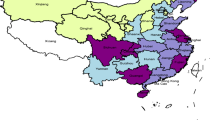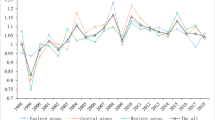Abstract
Agricultural green development is an essential direction for global sustainable agriculture. The academic literature, however, needs to place greater emphasis on studying the factors influencing agricultural green development performance and how such performance can be improved. A theoretical framework for agricultural green development performance was constructed in this paper using the Super-SBM model, which considers undesirable outputs, to measure the agricultural green development performance of 330 cities at or above the prefecture level in China (excluding Tibet Autonomous Region, Hong Kong, Macao and Taiwan of China) from 2007 to 2018. Furthermore, the influencing mechanism of agricultural green development performance was then analyzed using a spatial econometric model. The results show that: 1) from 2007 to 2018, China’s agricultural green development performance experienced three stages of evolution: ‘rise, decline and rise’. 2) The regions with high performance agricultural green development are mainly distributed in eastern China, northeastern China, and southern Qinghai Province. 3) The agricultural economic level, industrialization process, and labor quality play significant roles in promoting local agricultural green development performance, while such performance is obviously inhibited by the openness level and the government’s environmental regulations. Local agricultural green development performance is significant inhibited by the agricultural economic level and accelerated industrialization process in neighboring cities, while significantly promoted by the agricultural industrial structure in neighboring cities. Some suggestions for improving agricultural green development performance are proposed based on these research results, which can provide scientific references for promoting sustainable agriculture.
Similar content being viewed by others
References
Alarcón D, Bodouroglou C, 2011. Sustainable agricultural innovation systems (SAIS) for food security and green economies. In: The conference of Green Economy and Sustainable Development: Bringing Back the Social Dimension. United Nations Research Institute for Social Development. https://www.researchgate.net/publication/267202915
Ball V E, Lovell C A K, Luu H et al., 2004. Incorporating environmental impacts in the measurement of agricultural productivity growth. Journal of Agricultural and Resource Economics, 29(3): 436–460.
Basso B, Antle J, 2020. Digital agriculture to design sustainable agricultural systems. Nature Sustainability, 3(4): 254–256. doi: https://doi.org/10.1038/s41893-020-0510-0
Collins A L, Zhang Y S, Winter M et al., 2016. Tackling agricultural diffuse pollution: what might uptake of farmer-preferred measures deliver for emissions to water and air? Science of the Total Environment, 547: 269–281. doi: https://doi.org/10.1016/j.scitotenv.2015.12.130
Diakosavvas D, 2012. Green growth in agriculture and rural innovation systems-issues and challenges for policy. In: OECD’s 8th Rural Development Policy Conference, Innovation and Modernising the Rural Economy. Krasnoyarsk, Russian Federation.
Färe R, Grosskopf S, Norris M et al., 1994. Productivity growth, technical progress, and efficiency change in industrialized countries. The American Economic Review, 84(1): 66–83.
Hoang V N, Coelli T, 2011. Measurement of agricultural total factor productivity growth incorporating environmental factors: a nutrients balance approach. Journal of Environmental Economics and Management, 62(3): 462–474. doi: https://doi.org/10.1016/j.jeem.2011.05.009
Huang Xinquan, Feng Chao, Qin Jiahong et al., 2022. Measuring China’s agricultural green total factor productivity and its drivers during 1998–2019. Science of the Total Environment, 829: 154477. doi: https://doi.org/10.1016/j.scitotenv.2022.154477
Huang Yanzhong, Luo Xiaofeng, Li Zhaoliang, 2017. Analysis on spatial-temporal differences and influence factors of agricultural green production level in China. Journal of China Agricultural University, 22(9): 183–190. (in Chinese)
Izuogu C U, Ekweanya N M, Ifenkwe G E, 2015. Environmental hazard effects: critical issue relating to agricultural production of rural households in Imo State, Nigeria. The International Journal of Engineering Science, 4(11): 40–15.
Jin Saimei, 2018. Spatial correlation and influencing factors of agricultural green development in China. Commercial Science Research, 25(6): 44–52. (in Chinese)
Kalirajan K P, Obwona M B, Zhao S, 1996. A decomposition of total factor productivity growth: the case of Chinese agricultural growth before and after reforms. American Journal of Agricultural Economics, 78(2): 331–338. doi: https://doi.org/10.2307/1243706
Kea S, Shahriar S, 2022. Stochastic frontier analysis. In: Buhalis D (ed). Encyclopedia of Tourism Management and Marketing. Cheltenham: Edward Elgar Publishing, 251–254. doi: https://doi.org/10.4337/9781800377486.stochastic.frontier.analysis
Khan M S, 1987. Macroeconomic adjustment in developing countries: a policy perspective. The World Bank Research Observer, 2(1): 23–42. doi: https://doi.org/10.1093/wbro/2.1.23
Kiley-Worthington M, 1981. Ecological agriculture. What it is and how it works. Agriculture and Environment, 6(4): 349–381. doi: https://doi.org/10.1016/0304-1131(81)90039-4
Koohafkan P, Altieri M A, Gimenez E H, 2012. Green Agriculture: foundations for biodiverse, resilient and productive agricultural systems. International Journal of Agricultural Sustainability, 10(1): 61–75. doi: https://doi.org/10.1080/14735903.2011.610206
Kuosmanen T, 2013. Green Productivity in Agriculture: a Critical Synthesis. Helsinki: Aalto University.
Lai Siyun, Du Pengfei, Chen Jining, 2004. Evaluation of nonpoint source pollution based on unit analysis. Journal of Tsinghua University (Science and Technology), 44(9): 1184–1187. (in Chinese)
Lambert D K, Parker E, 1998. Productivity in Chinese provincial agriculture. Journal of Agricultural Economics, 49(3): 378–392. doi: https://doi.org/10.1111/j.1477-9552.1998.tb01279.x
Li Gucheng, 2009. Technical efficiency, technical progress and agricultural productivity growth in China. Economic Review, (1): 60–68. (in Chinese)
Li Lanlan, Zhu Kejun, Guo Haixiang, 2011. Empirical research on calculation of contribution rate of science and technology progress in provinces in China. China Population, Resources and Environment, 21(4): 55–61. (in Chinese)
Li Zhaoliang, Luo Xiaofeng, Xue Longfei et al., 2017. Agricultural green technical efficiency and its affecting factors in China. Journal of China Agricultural University, 22(10): 203–212. (in Chinese)
Li Zhuping, Li Shuying, Huang Zaichun, 2017. An empirical study on the environmental impact of China’s foreign agricultural trade. Jianghuai Tribune, (4): 25–29. (in Chinese)
Liang Jun, Long Shaobo, 2015. China’s agricultural green total factor productivity growth and its affecting factors. Journal of South China Agricultural University (Social Science Edition), 14(3): 1–12. (in Chinese)
Lin J Y, 1992. Rural reforms and agricultural growth in China. The American Economic Review, 82(1): 34–51.
Liu Lianfu, 2007. Green agricultural: a new model of agricultural development based on national conditions. China Report, (9): 100–103. (in Chinese)
Luan Jiang, Qiu Huanguang, Jing Yue et al., 2013. Decomposition of factors contributed to the increase of China’s chemical fertilizer use and projections for future fertilizer use in China. Journal of Natural Resources, 28(11): 1869–1878. (in Chinese)
McMillan J, Whalley J, Zhu L J, 1989. The impact of China’s economic reforms on agricultural productivity growth. Journal of Political Economy, 97(4): 781–807. doi: https://doi.org/10.1086/261628
Ministry of Agriculture and Rural Affairs of the People’s Republic of China, 2008–2019. China Agricultural Yearbook. Beijing: China Agriculture Press. (in Chinese)
National Leading Group of the First Pollution Source Census, 2009a. The First National Pollution Sources Survey: Handbook on the Fertilizer Loss Coefficient of Agricultural Pollution Sources. Available at: https://www.doc88.com/p-3367475355816.html. (in Chinese).
National Leading Group of the First Pollution Source Census, 2009b. The First National Pollution Sources Survey: Handbook on the Production and Discharge Coefficient of Livestock and Poultry Industry. Available at: https://ishare.iask.sina.com.cn/f/6zMoe4MClD.html. (in Chinese)
National Bureau of Statistics of China, 2008–2019a. China City Statistical Yearbook (2012–2016). Beijing: China Statistical Press. (in Chinese)
National Bureau of Statistics of China, 2008–2019b. China Rural Statistical Yearbook. Beijing: China Statistics Press. (in Chinese)
Oskam A, 1991. Productivity measurement, incorporating environmental effects of agricultural production. In: Agricultural Economics and Policy: International Challenges for the Nineties. Amsterdam: Elsevier, 186–204. doi: https://doi.org/10.1016/B978-0-444-88974-4.50023-1
Pan Dan, Ying Ruiyao, 2013. Agricultural eco-efficiency evaluation in China based on SBM model. Acta Ecologica Sinica, 33(12): 3837–3845. (in Chinese). doi: https://doi.org/10.5846/stxb201207080953
Peng Li, Su Chunjiang, Sun Lian et al., 2013. Spatial-temporal evolution pattern of agricultural productivity in northwestern Sichuan plateau. Journal of Mountain Science, 10(3): 418–427. doi: https://doi.org/10.1007/s11629-013-2392-4
Rao Jing, Xu Xiangyu, Ji Xiaoting, 2011. Study on the present situation, occurrence mechanism and countermeasures of agricultural non-point source pollution in China. Issues in Agricultural Economy, (8): 81–87. (in Chinese)
Stiglitz J E, 1987. Some theoretical aspects of agricultural policies. The World Bank Research Observer, 2(1): 43–60. doi: https://doi.org/10.1093/wbro/2.1.43
Swinnen J F M, Vranken L, 2010. Reforms and agricultural productivity in Central and Eastern Europe and the Former Soviet Republics: 1989–2005. Journal of Productivity Analysis, 33(3): 241–258. doi: https://doi.org/10.1007/s11123-009-0162-6
Tone K, 2004. Dealing with undesirable outputs in DEA: a Slacks-Based Measure (SBM) approach. In: Summary of the spring research conference of the Japan Society for Operational Research, 44–45. https://orsj.org/wp-content/or-archives50/pdf/a_s/2004_044.pdf
Tu Zhengge, Gan Tianqi, 2019. Research on the regional difference and dynamic mechanism of agricultural green development in China. Wuhan University Journal (Philosophy & Social Science), 72(3): 165–178. (in Chinese)
Xu Xiaocang, Huang Xiuquan, Huang Jun et al., 2019. Spatial-temporal characteristics of agriculture green total factor productivity in China, 1998–2016: based on more sophisticated calculations of carbon emissions. International Journal of Environmental Research and Public Health, 16(20): 3932. doi: https://doi.org/10.3390/ijerph16203932
Wang Jue, Song Wenfei, Han Xianfeng, 2010. Spatial econometric analysis of agricultural TFP and its influencing factors in China: based on provincial spatial panel data from 1992 to 2007. Chinese Rural Economy, (8): 24–35. (in Chinese)
Wei Yan, Gong Xinshu, 2012. The progress of science and technology, the upgrading of the industrial structure and regional employment differences: based on the empirical studies by 31 provincial panel data in the four major economic zones of China. Industrial Economics Research, (4): 19–27. (in Chinese)
Xu Bin, Chen Weitao, Zhang Guijun et al., 2020. How to achieve green growth in China’s agricultural sector. Journal of Cleaner Production, 271: 122770. doi: https://doi.org/10.1016/j.jclepro.2020.122770
Yang Qian, Wang Jue, Li Chao et al., 2019. The spatial differentiation of agricultural green total factor productivity and its driving factor recognition in China. The Journal of Quantitative & Technical Economics, 36(10): 36–37. (in Chinese)
Yu Weizhen, Luo Xiaofeng, Xue Longfei et al., 2018. Spatiotemporal differences and driving factors of green development in rural China. Journal of China Agricultural University, 23(9): 186–195. (in Chinese)
Zhan Jintao, Xu Yujiao, Ge Jihong, 2019. Change in agricultural green productivity in China considering the cost of carbon emissions. Resources Science, 41(5): 884–896. (in Chinese)
Zhang Bingfu, 2006. Analysis of theoretical misunderstanding of developing green agriculture. Social Science Journal, (5): 133–135. (in Chinese)
Zhang C, Shi G, Shen J et al., 2015. Productivity effect and overuse of pesticide in crop production in China. Journal of Integrative Agriculture, 14(9): 1903–1910. doi: https://doi.org/10.1016/S2095-3119(15)61056-5
Zhang Yi, He Youliang, 2010. Industrial structure change, factor reallocation and China’s economic growth. Economic Survey, (3): 27–31. (in Chinese)
Author information
Authors and Affiliations
Contributions
LI Erling: conceptualization, designing the analytical framework, writing-original draft preparation, writing-review and editing, supervision, coordinating the research team; ZHANG Mengzhen: methodology, performing the statistical analysis, writing-original draft preparation; LI Ruolan: investigation, data curation, software; DENG Qingqing: visualization, validation, writing-original draft preparation, writing-review and editing.
Corresponding author
Ethics declarations
LI Erling is an editorial board member of Chinese Geographical Science. She was not involved in the peer-review or handling of the manuscript. The authors have no other competing interests to disclose.
Additional information
Foundation item: Under the auspices of National Natural Science Foundation of China (No. 41971222, 42001190), Key R&D (Science and Technology) and Promotion Project of Henan Province (No. 222102110420), Key Research Project of Higher Education Think Tank in Henan Province (No. 2022ZKYJ06)
Rights and permissions
About this article
Cite this article
Li, E., Zhang, M., Li, R. et al. Influencing Factors and Improvement Suggestions for Agricultural Green Development Performance: Empirical Insights from China. Chin. Geogr. Sci. 33, 917–933 (2023). https://doi.org/10.1007/s11769-023-1385-6
Received:
Accepted:
Published:
Issue Date:
DOI: https://doi.org/10.1007/s11769-023-1385-6




